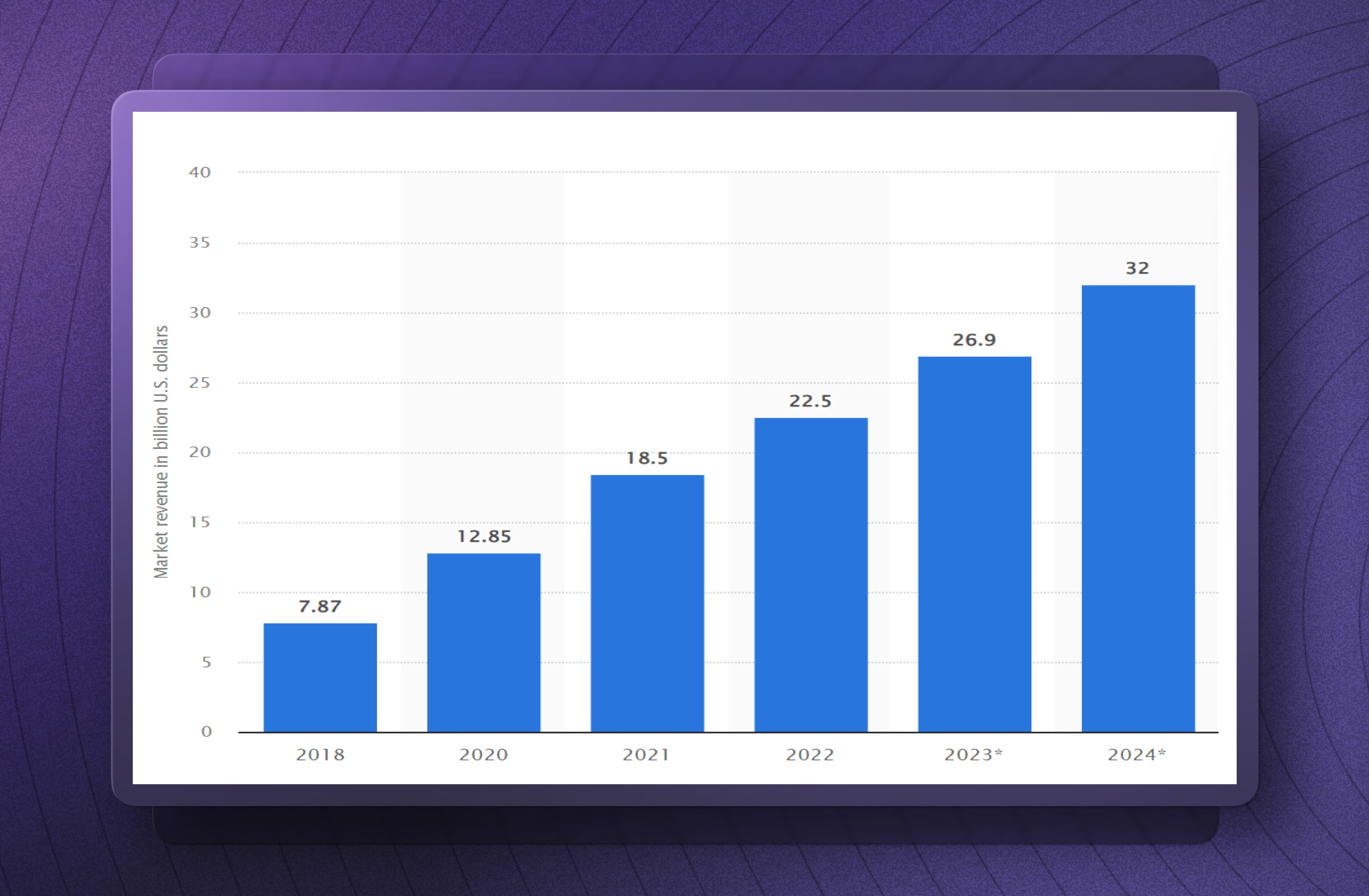A Complete Guide to Low Code ERP Solution Development


Managing traditional enterprise resource planning (ERP) systems' complexities and high maintenance costs can be overwhelming.
Extensive time and resources often lead to delays and budget overruns. Long coding cycles and the rigidity of off-the-shelf solutions also limit the ability to customize and adapt to your business's ever-changing demands.
Developing an enterprise resource planning solution using a low-code platform offers a refreshing alternative.
By bringing intuitive interfaces, pre-built templates, and drag-and-drop functionalities right to your fingertips, low-code ERP platforms simplify the development process. According to Statista, the global low-code platform market revenue is valued at almost 22.5 billion U.S. dollars in 2022 and is forecast to reach approximately 32 billion U.S. dollars in 2024.
This growth highlights the increasing recognition of low-code solutions' advantages—speed, flexibility, and reduced costs.

Source: Statista
This article explains how low-code ERP solutions transform traditional ERP systems, leading to greater efficiency, innovation, and operational excellence.
What is a low-code ERP system?
A low-code ERP system is a software platform created to streamline the configuration and deployment of ERP applications with minimal coding.
This modernized ERP system uses visual interfaces like drag-and-drop elements and pre-built templates to develop ERP solutions that amalgamate various business functions, such as accounting, customer relationship management, inventory management, and supply chain operations.
Low-code ERP systems allow organizations to quickly adapt and scale their ERP systems according to specific business needs without extensive coding requirements.
Example |
|---|
A manufacturing company can use a low-code platform to quickly develop a customized solution that integrates inventory management with supply chain workflows. Opting for a low-code approach allows the company to configure the application to automate notifications whenever stocks are low. After getting a notification, the company can schedule reorders and synchronize this data with its financial systems for real-time budget analysis. |
Now, let's discuss the common issues with traditional ERP systems to understand how low-code ERP can effectively address these challenges.
What are the top 5 challenges faced by traditional ERP systems?
Here are the top 5 challenges businesses face with traditional ERP systems. Let’s understand in detail.
1. Complex customization and maintenance of ERP systems
Traditional ERP systems often come with a rigid framework that requires extensive coding for customization. Developing this complex business application necessitates a team of experienced developers who are well-versed in the intricacies of the ERP's architecture.
As a result, businesses face prolonged implementation times and higher costs due to the dependency on specialized skills. Additionally, any subsequent changes or updates to the system further complicate maintenance efforts, leading to potential disruptions and increased operational expenses.
2. Limited scalability and flexibility of ERP software
A traditional ERP system often has a rigid and monolithic architecture, making altering or extending it difficult. Adding new features or making any changes would require extensive reconfiguration and customization.
The traditional ERP system’s generalized approach, which focuses on robustness and stability, leads to inflexible structures that are difficult to adapt to changing business requirements.
3. Traditional ERP systems are difficult to use
Traditional ERP systems are often not user-friendly, presenting a steep learning curve for employees. The interfaces can be cluttered and unintuitive, requiring extensive training for business users to become proficient.
This complexity can lead to low user adoption rates and frequent errors as employees struggle to navigate the system and perform their tasks efficiently. Additionally, the lack of user-friendly features and streamlined workflows can reduce overall productivity and increase user frustration, ultimately impacting business operations negatively.
4. Difficulty in integration with other systems
Traditional ERP systems typically have outdated architecture and lack modern integration capabilities, making it difficult to establish seamless connections with cloud-based services, mobile applications, and other contemporary IT ecosystems.
The absence of standardized APIs and modern integration protocols complicates the process, leading to increased time and costs for integration projects.
This difficulty in achieving effortless connectivity can hinder business agility, prevent real-time data sharing, and limit the ERP system's effectiveness in supporting diverse business operations.
5. Limited customization capabilities in ERP systems
Traditional ERP systems are designed to offer a one-size-fits-all solution, which can limit businesses with unique processes and requirements.
Customizing these systems to align with specific business workflows often requires significant effort and expertise, leading to extended project timelines and higher costs.
The inability to easily tailor the ERP system to evolving business needs can result in a lack of agility and misalignment with strategic goals, ultimately impacting operational efficiency.
Are you tired of dealing with inflexible, outdated ERP systems that drain your time and resources?
Discover how easy and cost-effective it is to build a customized, adaptable ERP system with our low-code platform.
How do low-code platforms help overcome the challenges of traditional ERP systems?
Here are the 4 pointers that help to understand how low-code platforms overcome the challenges of traditional ERP systems.
1. Seamless integration with existing ERP modules and external systems
Low-code platforms can integrate with existing ERP modules and other external systems. With the low code platform's integration capabilities, it is possible to connect to various data sources comprising databases like PostgreSQL and MySQL, as well as APIs and third-party services.
2. Scalable and cost-effective ERP development
Low-code ERP platforms enable organizations to add new functionalities and support increased workloads without extensive redevelopment or significant changes to existing infrastructure.
The visual development environment and reusable components specific to ERP systems reduce the time and resources required for expansions, making it easier for businesses to adapt and grow their ERP capabilities efficiently.
3. Streamlined ERP customization and quick implementation
Low-code-based enterprise systems enable businesses to quickly adapt ERP systems to meet specific operational needs with minimal coding. This capability significantly reduces the time and complexity involved in customizing ERP modules.
Additionally, low-code platforms facilitate rapid deployment of ERP solutions, enabling organizations to implement their systems faster than traditional methods. This customization and deployment allow you to respond promptly to changing market demands and internal requirements, enhancing overall efficiency and competitiveness.
4. Agile responses to business changes in ERP processes
Low-code ERP systems enable businesses to quickly respond to changes in the market, regulatory requirements, and internal operations. These platforms allow for fast adjustments within ERP processes, ensuring organizations can maintain flexibility and responsiveness.
Additionally, integration of BPM low-code solutions further improves the ability to streamline and automate complex business processes, providing a 360-degree view and approach to process management and improvement.
By supporting swift modifications, low-code ERP systems help businesses align their ERP solutions with evolving needs, ensuring continuous operational efficiency and competitiveness.
5. Enhanced user adoption and easier training of ERP system
Low-code ERP platforms feature intuitive user interfaces and role-based access controls that help employees quickly learn and effectively use the ERP system. These platforms simplify the user experience, reducing the need for extensive training.
With pre-built components and user-friendly design, low-code ERP systems ensure that business users of all technical backgrounds can easily understand and navigate the ERP applications, leading to higher adoption rates and more efficient operations.
Now that we've seen the advantages of low-code ERP, let’s understand the specific features that enable these benefits.
Key features of low-code ERP platform
Here are the key features of the low-code ERP platform
Features | Description |
Seamless ERP Integration | Integrate ERP systems with various data sources, including databases, APIs, and third-party services. |
Custom ERP Forms | Quickly design and deploy custom forms for ERP data entry, approval processes, and reporting. |
Role-Based Access Control | Define and manage user roles and permissions to secure sensitive ERP data. |
Mobile-Friendly ERP solution | Develop mobile-compatible ERP applications for on-the-go access to critical business functions. |
Scalable ERP Modules | Add or modify ERP modules to adapt to business needs without extensive re-coding. |
Pre-Built ERP Templates | Utilize pre-built templates for common ERP functions such as finance, HR, and supply chain. |
Real-Time ERP Analytics | Implement real-time data analytics for instant insights into ERP operations and performance. |
ERP Audit Trails | Implement detailed audit trails and compliance features to meet regulatory requirements. |
Automated Data Sync | Automatically synchronize data between different ERP modules and external systems in real-time. |
ERP Notification and Alerts | Create custom notifications and alerts for various ERP activities and events. |
Custom Reporting | Designed and generated custom reports tailored to specific business needs and requirements. |
Visual Process Modeling | Use visual tools to model and manage ERP business processes for better understanding and optimization. |
Multi-Language and Localization | Develop ERP applications that support multiple languages and localization to cater to global operations. |
ERP User Dashboards | Create personalized dashboards for business users to monitor key ERP metrics and performance indicators. |
Document Management | Integrate document management capabilities within the ERP system for easy storage, retrieval, and sharing. |
ERP Chatbots and Assistants | Implement chatbots and virtual assistants to help users navigate and interact with the ERP system efficiently. |
Advanced Search and Filtering | Provide advanced search and filtering options to locate specific data within the ERP system quickly. |
Batch Processing | Develop batch processing features to handle large volumes of data and transactions efficiently. |
Multi-Tenancy Support | Enable multi-tenancy to manage multiple business units or clients within a single ERP instance. |
ERP Data Validation Rules | Implement custom data validation rules to ensure data integrity and consistency across ERP modules. |
Ready to take your ERP to the next level?
With Appsmith's low-code platform, you can harness powerful features like customizable dashboards, automated workflows, and seamless integrations
Top 5 low-code ERP platforms for ERP solution development
Here is the list of the top low-code platforms for your business that help develop ERP-based solutions.
Low code platforms | Best for | Pricing plans |
Appsmith | Rapid low-code ERP development and building internal tools with AI-based functionalities | Free community edition with core functionalities for individual developers and small businesses. Usage-based pricing for business plans starts at $0.4 per hour of usage Enterprise plan with a custom quote |
Mendix | Accelerating application development & automating routine work | Free edition Basic plan starts at €52,50/month Standard plan starts at €900/month Custom quotes available |
Retool | Quickly building and deploying web apps | Free plan Team plan starts at $10/developer/month and $5/user/month Business plan starts at $50/developer/month and $15/user/month Enterprise plan with a custom quote |
OutSystems | Developing complex, enterprise-grade applications with high scalability requirements | Free personal edition available Developer cloud plan costs $36,300/year |
Power Apps | Building business apps quickly with seamless Microsoft ecosystem integration | Free plan Premium plan starts at $20/user/month |
Top use cases for low-code ERP platforms
Here are the top use cases for developing ERP solutions using low-code technology
1. Human resources management
Low-code platforms can develop comprehensive HR modules to manage employee records, automate payroll processing, and streamline recruitment and onboarding processes. These modules can handle personal information, job roles, performance reviews, salary calculations, tax deductions, job postings, application tracking, and onboarding workflows.
2. Inventory management solution
Low-code ERP systems can provide inventory management capabilities, including real-time stock tracking, warehouse, and supplier management. Businesses can monitor inventory levels, optimize warehouse operations, manage reorders, maintain supplier information, track purchase orders, and evaluate supplier performance.
3. Financial management solution
Low-code finance systems can automate accounts payable and receivable, expense management, budgeting, and forecasting. These modules can handle invoicing, payments, expense approvals, budget creation, and financial forecasting, helping businesses monitor and control finances efficiently.
4. Customer relationship management system
Low-code platforms can enhance CRM capabilities by tracking leads, managing sales pipelines, and automating follow-ups. Low-code CRM solutions can also integrate customer support features to manage inquiries, track support tickets, ensure timely issue resolution, and improve customer satisfaction and loyalty.
How to choose the right low-code ERP solution for your business
One of the most difficult decisions is choosing the right low-code ERP platform, which involves various critical factors. Follow these steps to make an informed decision:
1. Identify your business needs
Assess your current ERP requirements and pain points.
Identify which processes require improvement or automation.
List specific features and functionalities important for your ERP operations.
2. Evaluate platform capabilities
Find tools with robust low-code software development features.
Look for real-time data integration capabilities and customizable workflows.
3. Consider ease of use
Choose a platform with an intuitive interface and user-friendly design tools.
Ensure it has drag-and-drop functionalities for easy ERP application development.
Evaluate the available training resources for your team.
4. Check integration options
Ensure support for APIs and data connectors for seamless data exchange.
Confirm that the platform integrates smoothly with your core ERP systems and third-party applications.
5. Assess scalability and flexibility
Ensure the platform can scale with your business growth.
Verify that the platform has a flexible architecture that allows adding or modifying ERP modules.
6. Review security and compliance
Ensure the platform follows industry-standard security practices and regulations (e.g., GDPR, HIPAA).
Look for user access controls, audit trails, and data encryption features.
7. Consider cost and ROI
Compare pricing models to see if they align with your budget.
Calculate the ROI by considering long-term cost savings and efficiency gains
How Appsmith can help to build a low-code ERP solution
Here are the 6 steps to build a low-code custom ERP system using Appsmith:
Step 1: Define your requirements
Before beginning the development process, it's essential to understand clearly what your ERP needs to accomplish.
Consider the following:
User roles: Identify user roles and their permissions (e.g., Admin, HR, Finance, Inventory Manager).
Core features: Define the core features such as HR management, financial tracking, inventory control, and CRM.
Advanced features: Plan for AI-powered analytics, automated workflows, and customizable reports to enhance productivity and decision-making.
Integration needs: Determine the external services and APIs you'll need to integrate (e.g., accounting software, CRM, payment gateways).
Data structure: Outline the data structure, including the entities and relationships (e.g., Employees, Departments, Inventory Items).
Step 2: Design the UI of your ERP
Appsmith provides a drag-and-drop interface for designing the UI.
How?
Create a New Application: Start a new project in Appsmith.
Design Layouts: Use the widgets available in Appsmith to create various pages of your ERP.
Step 3: Develop core ERP modules
Begin creating the core ERP system modules using Appsmith's visual tools.
How?
Visual development tools: Use Appsmith’s drag-and-drop tools to design and develop each module.
Reusable templates: Create reusable templates and components to streamline development.
Customization: Ensure each module can be customized to meet changing business needs.
Step 4: Implement workflows and automation
Design and implement workflows to automate routine tasks and improve efficiency.
How?
Identify repetitive tasks: Identify repetitive tasks in each ERP module that can be automated.
Workflow process automation tools: Use Appsmith's workflow automation tools to create and manage these processes.
Testing: Test workflows to ensure they function efficiently and effectively.
Step 5: Integrate with third-party systems
Ensure your ERP system can seamlessly integrate with other essential business applications.
How?
APIs and Connectors: Appsmith can integrate with existing systems such as accounting software and CRM.
Testing: Test the integrations to ensure seamless data flows between systems.
Step 6: Test, deploy, and train users
Ensure your ERP system works as expected and deploy it for users.
How?
Testing: Test all functionalities thoroughly to catch and fix bugs. Validate data integrity and user permissions.
Deployment: Deploy your application on Appsmith Cloud or self-host it using your infrastructure.
Training: Create training materials and conduct training sessions for end-users.
Support: Offer ongoing support to address issues and help users transition smoothly.
Ready to build your ERP with low-code?
Low-code platforms make building a customized ERP system easier and more cost-effective. These tools offer drag-and-drop interfaces, pre-built components, and seamless integrations, enabling quick and efficient ERP development for developers and non-developers alike.
Ready to transform your ERP? Start building with Appsmith today. As an open-source, low-code platform, Appsmith offers flexibility, usage-based pricing, no vendor lock-in, and extensive customization.
Key Highlights of Appsmith |
|---|
100k+ users worldwide 25+ native integrations Offers over 45 widgets In-built JavaScript editor Solid 256-bit encryption 6k+ Discord users |
Start building your tailored ERP with Appsmith today. Book a demo to discover how Appsmith can streamline your ERP development with its powerful low-code platform.
Frequently asked questions about low-code ERP development
1. Is low-code ERP suitable for small businesses?
Low-code ERP is a great platform for small businesses, offering scalable, flexible, and cost-effective solutions. It allows quick application development and customization without extensive coding knowledge. Low-code ERP can boost small businesses' overall performance by improving efficiency, streamlining operations, and quickly adapting to changing business needs.
2. Which industries can benefit the most from low-code ERP solutions?
Manufacturing, retail, healthcare, financial services, and logistics are industries that benefit most from low-code ERP solutions. These sectors deal with complex processes and large amounts of data, making them ideal candidates for low-code ERP systems' customizable, efficient, and scalable nature.
3. What are the key metrics to measure the success of a low-code ERP implementation?
Key metrics to measure the success of a low-code ERP implementation include deployment time, user adoption rates, operational efficiency improvements, and cost savings. These metrics help assess how quickly the system was implemented, how effectively it is being used, its impact on business processes, financial benefits, and overall user feedback.
4. How do low-code ERP solutions handle data migration from legacy ERP systems?
Low-code ERP solutions use robust tools and automated processes to migrate data from legacy systems. They include pre-built connectors and data mapping capabilities to ensure smooth and accurate data transfer. These platforms also offer features to validate data integrity, minimize disruptions, and streamline the migration process, ensuring that critical business information is preserved and properly integrated into the new system.
5. What are the cost implications of switching to a low-code ERP system?
The cost implications of switching to a low-code ERP system include initial investment in the platform, potential costs for training and support, and ongoing subscription or usage fees. However, these costs are often offset by significant savings in development time, reduced need for extensive IT resources, and lower maintenance expenses. Additionally, low-code ERP systems' increased efficiency and flexibility can lead to long-term financial benefits, making the transition cost-effective for many businesses.


